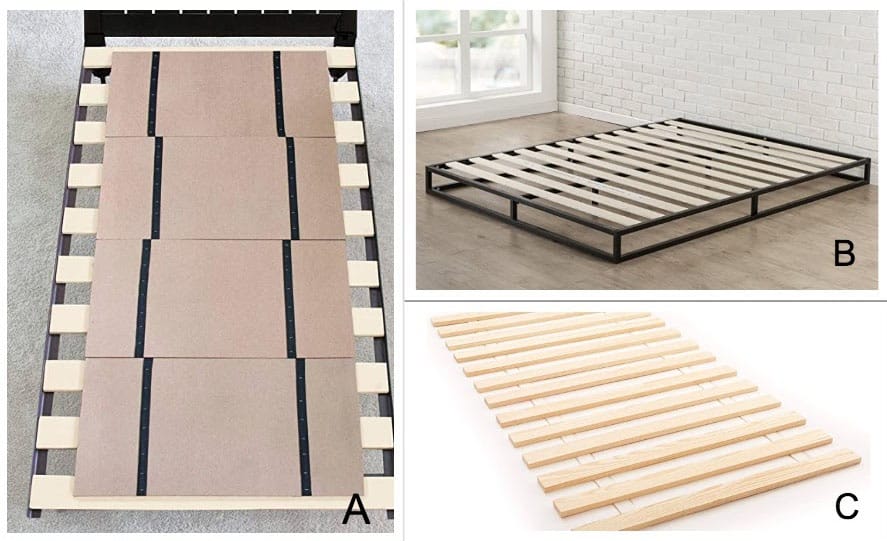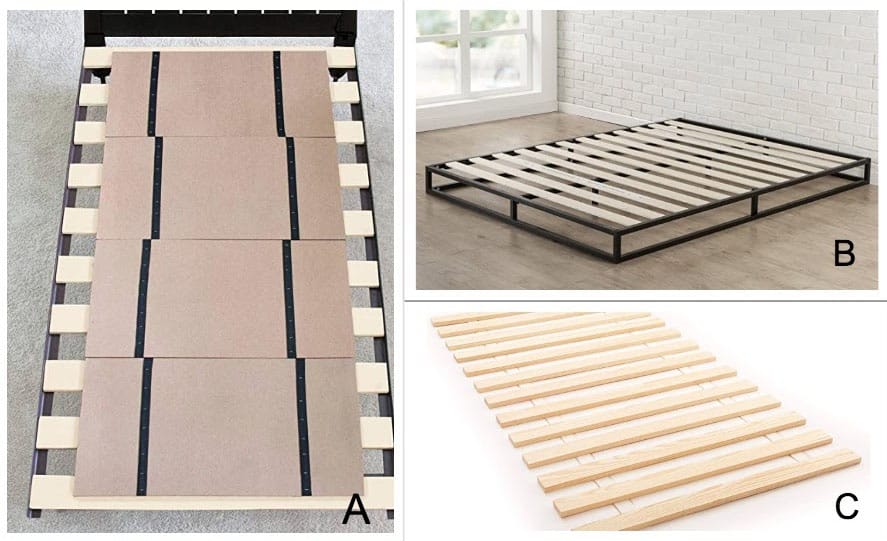Providing the right support for your mattress is fundamental in order to keep your mattress in good condition and to help you stay well rested. You have many options when it comes to selecting a base or a foundation type for your mattress. It all depends on your mattress type, your bedroom style, and your budget. If you have a foam mattress, you will want to choose a mattress foundation that will provide the best support for that type of mattress. Since bunkie boards are a popular and affordable mattress foundation, you may be wondering if you need a bunkie board under a foam mattress.
You need a bunkie board or alternative mattress support under a foam mattress because it withstands heavy weight from mattresses and ensures optimal support, comfort, and durability.
Bunkie boards are solid, sturdy platforms that attach to a bed frame or rest on top of a slatted bed base to add further mattress support. Modern bunkie boards can also be made of wooden or metal slats placed close together to allow proper ventilation and even weight distribution. However, a bunkie board with slats will only be supportive enough if the slats are wide and spaced tightly enough to protect the mattress from sagging.
Given the fact that foam mattresses, latex foam mattresses, and memory foam mattresses are all dense and heavy, they require additional support and breathability.
You will learn how bunkie boards offer unique benefits in the following sections.
Related articles:
- What are some bunkie board alternatives?
- Can a bunkie board replace slats?
- How much weight does a bunkie board hold?
Do You Need a Bunkie Board Under a Latex Foam Mattress?
Latex foam mattresses are known for being elastic and durable. They are dense and heavy, just like any foam mattress. Therefore, they require a sturdy base underneath. So, does that mean that you need a bunkie board under a latex foam mattress?
Yes, you do need a bunkie board under a latex foam mattress because latex foam is heavy, elastic, breathable, and can break down over time. A bunkie board will help prolong the life of your latex foam mattress.
Latex foam mattresses are dense in order to help absorb shock. Bunkie boards, whether made of a whole plank or of slats, are sturdy enough to support and bear the extra weight of latex foam mattresses. However, the slats have to be wide, thick and spaced less than three inches apart to provide even weight distribution. Hardwood and metal rods support heavy weights better than plywood, so look for those materials when selecting a bunkie board for a latex foam mattress.
Latex foam mattresses also react to movement. Whenever you move in bed, the mattress will dig in at specific points and mold to your body. Because of this, the mattress needs a foundation that offers constant and uniform support, like a bunkie board.
Mattresses made of latex foam have pinholes and are made of open-cell foam, which allows air circulation through the mattress. A solid flat surface right beneath the mattress will block the airflow and thus cause the mattress to trap body heat and sweat. Because of this, it’s best to choose a slatted bunkie board in order to support your latex mattress without sacrificing ventilation.
Latex foam mattresses are durable but they can still sag and dip, especially if you have the wrong base underneath your mattress. If the slats of your bed base are widely spaced, they can damage your mattress and reduce its longevity. The elastic latex can dip into the gaps and sag prematurely. This is when a flat bunkie board comes in handy: they prevent the mattress from sagging while maintaining proper support.
Do You Need a Bunkie Board Under a Memory Foam Mattress?
Memory foam mattresses are known for their elasticity and density. They tend to compress slowly when pressure is applied but then bounce back to their original form once the pressure is released. They are denser than all other foam mattresses, and a lack of support will cause them to sag. So, do you need a bunkie board under a memory foam mattress?
Yes, you will need a bunkie board under a memory foam mattress. A bunkie board is the best foundation type for memory foam mattresses because they provide a high level of support for the foam core.
However, a flat bunkie board will reduce the mattress’s breathability, which may lead to moisture and mildew buildup within the mattress. For more information on how a mattress’ breathability can affect sleep, see this article from the Journal of Thermal Biology.
Slatted bed bases work well by providing solid support and ventilation, but the gaps between the slats can damage the mattress and reduce its lifespan. A bunkie board that sits on top of the slats will prevent the mattress from bending into the gaps and will, therefore, maintain its structure and functionality.
How Slat Spacing Affects How Bunkie Boards Support Foam Mattresses
Bunkie boards made of wooden or metal slats work well with foam mattresses as long as the slats are less than three inches apart from one another. But how exactly does slat spacing affect how bunkie boards support foam mattresses?
When the slats are close enough together, they provide solid and even weight distribution and thus enable proper body support. If the slats are too widely spaced, they will dig into the mattress, causing it to sag.
In that case, the slats will not only affect the mattress: they will affect your comfort and posture, too. For more information on weight distribution, see this 2014 study. Sometimes the maximum slat gap will be indicated on your mattress warranty. Always make sure to get a bunkie board with slats not exceeding the indicated slat gap, otherwise, it will void your mattress warranty.
Alternatives to Using a Bunkie Board Under a Foam Mattress
A bunkie board is not the only type of mattress foundation that you can use under a foam mattress for proper support. In fact, there are a few different alternatives to using a bunkie board under a foam mattress.
 Different foundations for foam mattresses: Plywood laid over a slatted bed base (A), a platform bed with built-in wooden slats (B), and wooden slats (C). Image from Amazon.
Different foundations for foam mattresses: Plywood laid over a slatted bed base (A), a platform bed with built-in wooden slats (B), and wooden slats (C). Image from Amazon.Some alternatives to using a bunkie board under a foam mattress include plywood, slats, and platforms. Each of these alternatives provides great support for foam mattresses.
Plywood is a thin, light, and rigid material. However, it will need to be treated and laminated; otherwise, it will chip and snag on your mattress. The plywood needs to be at least one inch thick to provide minimal support for your mattress. For more information, refer to this article: Can You Use Plywood Instead Of A Bunkie Board?
Slats are thin and light, and they promote proper support and breathability for your mattress. As mentioned when discussing slatted bunkie boards, the gap between the slats should be less than three inches. Otherwise, the slats can dig into the mattress and damage it.
Platform beds provide a built-in support surface for any type of mattress. The support surface of a platform bed may be flat, or it may have slats. A flat base will be rigid enough to support foam mattresses, but it may block air circulation through the mattress. On the other hand, a base with slats will promote proper ventilation and even weight distribution, but it may be more prone to break than a flat surface.
How To Choose a Bunkie Board for a Foam Mattress
There are many bunkie boards on the market, so choosing the right one is not an easy task. If you don’t know which factors to consider when making your decision, it may be confusing to determine how to choose a bunkie board for a foam mattress.
In order to choose a bunkie board for a foam mattress, you must decide where you want to use it, the size of the bunkie board you will use, the material of the bunkie board, and whether you want your bunkie board to have a noise-reduction feature.
To choose a bunkie board for a foam mattress, follow these steps:
Step 1. Decide where you want to use it
Bunkie boards can be attached to metal or wooden bed frames, or placed on top of slats or old box springs. They can even be laid on the floor. Therefore, the first thing you need to do is figure out where you want to put your bunkie board. Do you want to put it on a platform bed, a daybed, a trundle bed, or simply on the floor?
Related articles:
Step 2. Pick the size of the bunkie board
The bunkie board has to be compatible with both the bed frame and the mattress. Measure the size of your mattress and choose a bunkie board with the same dimensions. Make sure that the board is not too small or too large so that it fits the bed frame properly.
Step 3: Choose the material of the bunkie board
The rigidity of the material used is what guarantees proper support. Bunkie boards can be made of plywood, hardwood, particleboard, or steel. Choose the best material in terms of weight capacity and durability. For more information on this, refer to this article: What are bunkie boards made of? What is the best bunkie board material?
You may also enjoy reading about how long do bunkie boards last?
Step 4: Select a noise-reduction feature for the bunkie board
When you toss and turn in bed, your mattress may slip and rub against the plank or the slats of your bunkie board. Sometimes this can cause irritating sounds, so look for a noise-free bunkie board that is covered with a quilted or upholstered fabric. Some bunkie boards come with foam-padded tape, which minimizes these sounds and helps make your sleep more agreeable.
Related article: How to fix a squeaky bunkie board
Three examples of great bunkie boards for foam mattresses include the following:
| Product Name + Link to Amazon | Why is this a good bunkie board for a foam mattress? | Price |
| The Mattress Solution |
Provides a solid foundation Extends the lifespan of the mattress Bears the heavy mattress without adding too much height |
~$230 |
| Zinus Annemarie |
Offers high-level support Does not require assembly |
~$70 |
| Zinus Gulzar |
Offers mattress support and improves durability Assembles quickly and easily Includes noise-reduction, feature, and foam-padded tape |
~$60 |
Related Article:
- Make sure you choose the right bunkie board based on costs of different features (here’s our guide).
Summary
In the past, people used box springs to support and elevate the height of their mattresses. However, platforms, bunkie boards, and slatted foundations are great alternatives that have become more popular and tend to work best with foam mattresses. We also have a great article on box spring alternatives and a mattress foundation disposal and donation guide in case you’re interested.
We hope you enjoyed this article and found it useful. Now you should have a good idea about how bunkie boards can benefit foam mattresses and memory foam mattresses.

